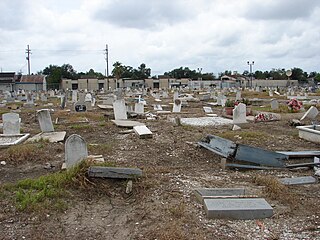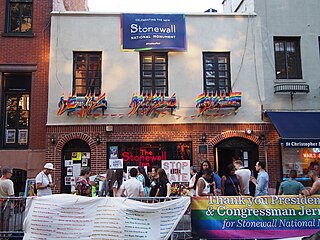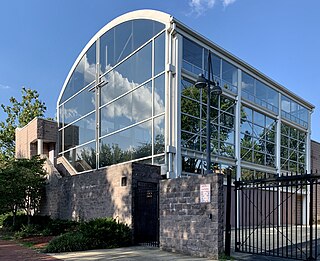
The Metropolitan Community Church (MCC), also known as the Universal Fellowship of Metropolitan Community Churches (UFMCC), is an international LGBT-affirming mainline Protestant Christian denomination. There are 222 member congregations in 37 countries, and the fellowship has a specific outreach to members of the LGBT community.
This is a list of notable events in the history of LGBT rights that took place in the year 1973.

NLGJA: The Association of LGBTQ+ Journalists, is an American professional association dedicated to coverage of LGBTQ+ issues in the media. It is based in Washington, D.C., and the membership consists primarily of journalists, students, educators, and communications professionals. The organization was previously known as the National Lesbian and Gay Journalists Association (NLGJA), but changed its name in 2013 to "NLGJA: The Association of LGBT Journalists" to reflect the diversity of the communities it represents. In 2016, it added a "Q" to represent queer journalists and people, updating its name to "NLGJA: The Association of LGBTQ Journalists". In 2023, it added a "+" to represent those gender-diverse and sex-diverse people whose identities are not well-known to be added to the acronym, and those who are questioning their identities, updating its name to "NLGJA: The Association of LGBTQ+ Journalists".

Troy Deroy Perry Jr is an American cleric and the founder of the Metropolitan Community Church, with a ministry with the lesbian, gay, bisexual, and transgender communities, in Los Angeles on October 6, 1968.

Gregory Michael Aymond is an American prelate of the Catholic Church who has served as the Archbishop of New Orleans since 2009.
The Rainbow Lounge raid occurred in the early morning hours of June 28, 2009, at the Rainbow Lounge, a newly opened gay bar in Fort Worth, Texas. The raid was carried out by members of the Texas Alcoholic Beverage Commission (TABC) and the Fort Worth Police Department. Several customers were arrested for public intoxication and one customer, Chad Gibson, received a severe head and brain injury while in custody. The police also claimed the customers made sexual advances and contact with them. Other customers were detained and later released without arrest.

Royd Anderson is a Cuban-American filmmaker and historian based in New Orleans, Louisiana. He specializes in documentary films pertaining to tragic Louisiana events often overlooked by historians.
Finis Alonzo Crutchfield Jr. was a noted American clergyman and a bishop in the United Methodist Church. He began his pastoral career after graduating from Duke University Divinity School in 1940. His first assignment was First United Methodist Church in Oklahoma City, Oklahoma. He remained there until he was sent to Norman, Oklahoma, in 1950. Ten years later he became senior pastor at Boston Avenue Methodist Church in Tulsa. He was credited with bringing Oral Roberts into the Methodist Church and served as a negotiator in the 1968 merger of the Methodist Church with the Evangelical United Brethren Church.
Sally Huffer is an American LGBT activist that resides in Houston.
Metropolitan Community Church of New Orleans is an LGBT-affirmative church in New Orleans. It is a member of the Metropolitan Community Church denomination, and has not held a dedicated edifice for the majority of its history.

Seattle Pride refers to a series of events which are held annually throughout the month of June to celebrate LGBT Pride in Seattle, Washington. Seattle Pride also refers to the nonprofit organization Seattle Out and Proud which coordinates and promotes LGBTQIA+ events and programs in Seattle year-round including the Seattle Pride Parade.

Holt Cemetery is a potter's field cemetery in New Orleans, Louisiana. It is located next to Delgado Community College, behind the right field fence of the college's baseball facility, Kirsch-Rooney Stadium. The cemetery is named after Dr. Joseph Holt, an official of the New Orleans Board of Health who officially established the cemetery in the 19th century. Holt Cemetery is one of the Historic Cemeteries of New Orleans.

Pulse was a gay bar, dance club, and nightclub in Orlando, Florida, founded in 2004 by Barbara Poma and Ron Legler. On June 12, 2016, the club was the scene of the second worst mass shooting by a single gunman in U.S. history, and the second deadliest terrorist attack on U.S. soil since the September 11 attacks. Forty-nine people were killed and 53 other people were injured.

The View UpStairs is a musical with music, lyrics and book by Max Vernon based on the real-life events of the 1973 arson attack at the UpStairs Lounge, a gay bar in New Orleans. This attack resulted in the deaths of 32 people, the deadliest attack on a gay club in U.S. history before the 2016 Orlando nightclub shooting. The show is inspired by and pays tributes to many of the patrons who frequented the venue.

This is a timeline of notable events in the history of the lesbian, gay, bisexual, and transgender community in the United States.

The Louisiana Library Association (LLA) is a professional organization for Louisiana's librarians and library workers. It is headquartered in Baton Rouge, Louisiana. The LLA publishes The LLA Bulletin (est. 1937) and Louisiana Libraries magazine.

The Metropolitan Community Church of Washington, D.C. is a congregation of the Metropolitan Community Church (MCC), a Protestant Christian denomination catering to LGBT people, located in the Mount Vernon Square neighborhood of Washington, D.C. Founded in 1970 as the Community Church of Washington, D.C. (CCDC), the congregation led by Pastor Paul Breton joined the new MCC denomination in 1971 with help from local activist Frank Kameny.
On August 5, 1969, the Atlanta Police Department led a police raid on a screening of the film Lonesome Cowboys at a movie theater in Atlanta, Georgia, United States.
Upstairs Inferno is a 2015 American documentary film written, produced, and directed by Robert L. Camina. It chronicles the events surrounding the UpStairs Lounge arson attack on June 24, 1973, in New Orleans, Louisiana and the city's response to the tragedy.













